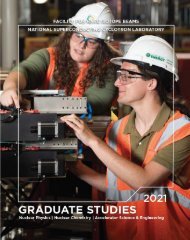202 FRIB Graduate Brochure
You also want an ePaper? Increase the reach of your titles
YUMPU automatically turns print PDFs into web optimized ePapers that Google loves.
Steven Lidia<br />
Senior Physicist and Adjunct Professor of Physics<br />
and Electrical and Computer Engineering<br />
Keywords: Accelerator Systems, Beam Diagnostics High-Performance Controls,<br />
Advanced Instrumentation, High Brightness Beams<br />
Accelerator Physics<br />
About<br />
• PhD, Physics, University of California at Davis, 1999<br />
• Joined the laboratory in August 2016<br />
• lidia@frib.msu.edu<br />
Research<br />
Contemporary and planned accelerator facilities are<br />
pushing against several development frontiers. Facilities<br />
like the Facility for Rare Isotope Beams, the European<br />
Spallation Source, FAIR@ GSI, IFMIF, SARAF, and others<br />
are currently expanding the limits of the intensity frontier<br />
of proton and heavy ion beams. These high-intensity<br />
hadron beams are intrinsically useful for nuclear science<br />
as they permit exploration of low cross section reactions<br />
with reasonable experimental data collection rates. These<br />
same beams, however, also present distinct hazards<br />
to machine operation from uncontrolled beam losses.<br />
Optimum scientific performance of these facilities requires<br />
us to predict and measure the behavior of intense beams.<br />
The development of diagnostic techniques and advanced<br />
instrumentation allows the accelerator scientist to create<br />
and to tune beamlines that preserve beam quality measures<br />
while allowing for precise manipulation and measurement<br />
of the beam’s energy, intensity, trajectory, isotope content,<br />
and phase space density and correlations. We utilize<br />
sophisticated codes to model the dynamics of multicomponent<br />
particle beams and their electromagnetic,<br />
thermal, and nuclear interactions with materials and<br />
devices. We design sensor devices and components<br />
that enable us to make specific measurements of beam<br />
parameters. These sensors are paired with electronic<br />
signal acquisition, analysis, and control systems to provide<br />
timely data that permit beam tuning and to monitor beam<br />
behavior and beamline performance. These systems are<br />
built and tested in the laboratory before commissioning<br />
with beam.<br />
Like accelerator science, in general, development<br />
of diagnostic and control techniques involve the<br />
understanding and utilization of diverse subject matter<br />
from multiple physics and engineering sub-disciplines.<br />
prediction and measurement of beam instabilities; and<br />
development of electronics, firmware, and software to<br />
interface with these sensors. Specific instrumentation<br />
developments will enable non-intercepting bunch<br />
length and profile measurements, monitors for ion beam<br />
contaminant species and diffuse beam halo, machine<br />
learning techniques for integrating loss monitor networks,<br />
and compact sources of soft x-rays for nuclear structure<br />
measurements.<br />
Time-averaged phase space density measurements of<br />
30 mA, 130 keV Li+ beam using scanning slit and slit<br />
Faraday cup.<br />
Selected Publications<br />
P. N. Ostroumov, S. Lidia, et al, “Beam commissioning<br />
in the first superconducting segment of the Facility for<br />
Rare Isotope Beams”, Phys. Rev. Accel. Beams 22, 080101<br />
(2019).<br />
P.A. Ni, F.M. Bieniosek, E. Henestroza and S.M. Lidia, “A<br />
multi-wavelength streak-optical- pyrometer for warmdense<br />
matter experiments at NDCX-I and NDCX-II”, Nucl.<br />
Instrum. Methods Phys. Res. A 733 (2014), 12-17.<br />
J. Coleman, S.M. Lidia, et. al., “Single-pulse and multipulse<br />
longitudinal phase space and temperature measurements<br />
of an intense ion beam”, Phys. Rev. ST Accel. Beams 15,<br />
070101 (2012).<br />
Current projects within the group are centered on<br />
measurements to understand the behavior of intense,<br />
multi-charge state ion beams; high sensitivity and high<br />
speed sensors and networks for beam loss monitoring;<br />
accurate beam profile monitoring and tomography;<br />
non-invasive beam profile measurement techniques;<br />
57<br />
<strong>202</strong>2_<strong>FRIB</strong>_<strong>Graduate</strong>_<strong>Brochure</strong>v4.indd 57<br />
10/29/<strong>202</strong>1 3:33:53 PM






